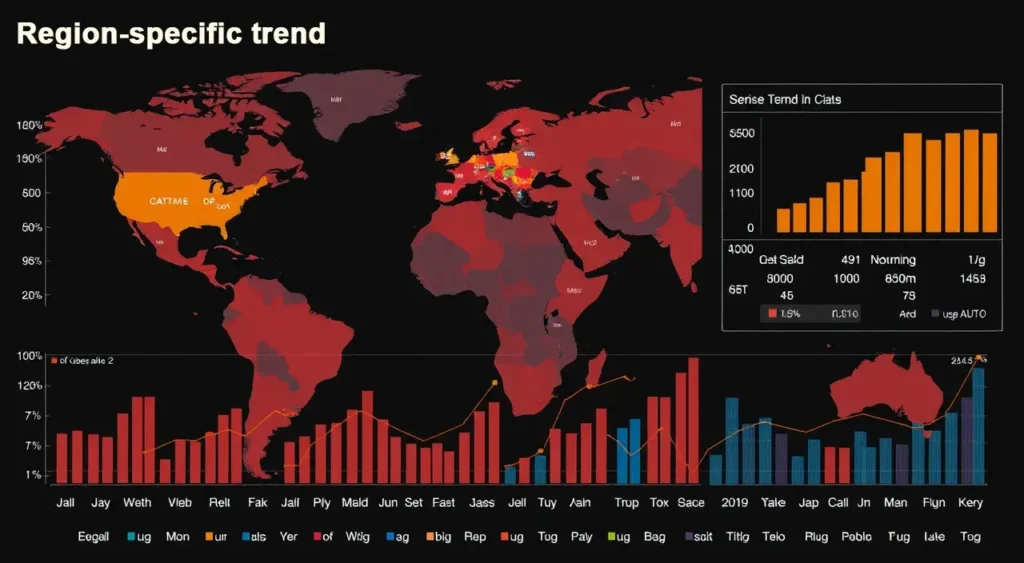
Why Global Trend Data Doesn’t Tell the Whole Story
The illusion of universal behavior
Global trend tools like Google Trends or Twitter’s trending topics often present a one-size-fits-all view of what’s “hot.” But that’s rarely the full picture.
Consumer behavior, culture, and even digital habits vary drastically between regions. A top trend in New York may be invisible in Nairobi or Seoul.
So, if you’re relying solely on global signals, you might miss out on the hyperlocal drivers that actually impact your audience.
Regional blind spots are real
Relying on global tools creates blind spots. They filter out low-volume but high-impact regional trends.
That’s a problem—especially for marketers, analysts, and product developers. These “micro-trends” can be early indicators of broader shifts.
Ignoring them can make your strategy feel out of touch—or worse, irrelevant.
The Rise of Geo-Specific Trend Platforms
Tools built with local insight in mind
We’re seeing a new wave of platforms focused on geo-targeted analytics—and it’s long overdue. Platforms like Trendinalia, GlobeTrends, and even localized dashboards in Google Trends are stepping up.
They don’t just show what’s trending—they show where and why.
By narrowing the scope to city, region, or language group, these tools uncover trends that would otherwise be lost in the noise.
Meeting users where they actually are
This matters more than ever in a fragmented online world. Your audience isn’t just “global”—they live, shop, and talk locally.
With region-specific tools, you can connect with real behavior, not just statistical outliers or hype-driven buzz.
It’s about making localized content decisions that stick.
Cultural Nuance: The Invisible Algorithm
Trends speak different languages—literally
Let’s not forget that culture drives context. What sparks a viral moment in Tokyo might feel irrelevant in Toronto.
Even when people search for the same topic, they phrase it differently. That means standard algorithms often miss culturally embedded keywords.
And the result? You might optimize for a term that has no traction in your actual target region.
You can’t localize what you can’t see
Region-specific tools help identify language quirks, slang, and culturally charged terms that global tools gloss over.
This leads to richer insights—and way fewer misfires in communication.
Did You Know?
In 2024, over 60% of trending topics in Nigeria didn’t appear on global Twitter trends at all.
Local Trend Tools Unlock Better Business Strategy
Beyond marketing: product, UX, and policy decisions
Using regional trend tools isn’t just about SEO or content calendars. It has broader strategic value.
For example, product teams can identify regional feature requests. UX designers can tailor flows to local behavior. Even public policy efforts benefit from real-time, place-specific sentiment.
Predictive value is higher with local data
Micro-trends often foreshadow macro changes. Spotting them early can give you first-mover advantage.
If a certain topic is heating up in São Paulo but hasn’t gone global yet, your brand can position ahead of the curve.
From Localization to Hyperlocalization
Granular is the new gold
Localization used to mean translating content. Now, it means tuning into street-level insight.
Hyperlocal tools allow you to zoom in on trends by ZIP code, city borough, or even neighborhood sentiment clusters.
For local businesses, this is transformative. But even global brands benefit—because loyalty starts in the details.
Personalization that actually resonates
Hyperlocal trend insights can shape campaigns that feel truly personal. It’s about relevance at scale, not mass-produced messaging.
When your tone, timing, and touchpoints feel tailored? You earn trust—and attention.
What’s Coming Next
Now that we’ve looked at why region-specific tools matter, let’s explore the technologies and data models making them possible.
Next up: smart algorithms, real-time pipelines, and how AI is learning to think locally.
How AI is Powering Local Trend Discovery

Algorithms tuned for geography and dialect
Old-school trend tools relied heavily on keyword volume. But today’s AI models can detect semantic meaning across dialects and locations.
That means they don’t just “count searches”—they understand intent.
Machine learning models now ingest geo-tagged data, social sentiment, and even local idioms. This allows platforms to highlight emerging patterns before they spike globally.
Real-time data, real-world relevance
Local AI tools work in real time, reacting faster to regional shifts.
Let’s say a slang term starts gaining traction in Johannesburg. Traditional tools might ignore it due to low volume. But AI-driven models flag the trajectory, not just the numbers.
This makes local tools not just reactive—but predictive.
Data Pipelines That Respect Local Complexity
Regional filtering for accuracy
Not all data is created equal. If your pipeline doesn’t account for location metadata, you’re working with blurry vision.
Modern tools integrate geolocation, timezone patterns, and platform-specific behavior. That way, the data you act on is actually locally grounded.
Think of it like turning on HD for the first time. Everything gets sharper—and more actionable.
Multi-source integration
The best regional trend tools don’t rely on one source. They aggregate across:
- Local social media activity
- Search behavior segmented by region
- Public datasets and event calendars
- Local news trends and influencer chatter
This hybrid approach leads to richer and more reliable trend detection.
Use Cases Across Industries
E-commerce and retail
For retailers, regional trend tools can inform:
- Local inventory adjustments
- In-store promotions tied to hyperlocal events
- Personalized recommendations by ZIP code
Imagine knowing what sneakers are trending in Brooklyn before they sell out citywide.
Journalism and media
Reporters can use local trend dashboards to source story ideas, validate angles, or spot viral movements early.
Instead of guessing what’s “hot,” they work with data-backed intuition.
Civic planning and public health
Cities are using trend tools to track sentiment around housing, transit, and healthcare access.
Real-time insight leads to faster, more responsive policies.
Why Brands Need to Act Local, Even at Scale
National campaigns miss nuance
A campaign that crushes it in one state may flop in another. National averages hide critical regional differences.
Using trend data at the regional level lets brands build micro-campaigns that connect more deeply.
And today, scale doesn’t mean uniformity. It means synchronized personalization.
The power of cultural fluency
Cultural cues change across cities—even neighborhoods. A well-placed reference or locally relevant meme can supercharge engagement.
But miss the mark? You risk being ignored—or mocked.
Regional tools give marketers a cultural compass, not just a spreadsheet.
The New Competitive Edge: Local Intelligence
Small signals, big impact
The brands winning today aren’t just louder—they’re smarter. They move on insights before the competition even sees them.
Micro-signals in local data—search spikes, hashtag momentum, event chatter—often precede national relevance.
Acting early turns local intelligence into market advantage.
First-mover advantage is real
From product launches to influencer outreach, the edge goes to those who spot trends early.
With the right local toolset, you stop reacting and start leading.
Case Studies Illustrating the Impact of Region-Specific Tools

E-commerce Personalization: An online retailer implemented region-specific trend analysis to tailor its marketing strategies. By analyzing local search behaviors and purchasing patterns, the company customized promotions for different regions, resulting in a 20% increase in conversion rates compared to generic campaigns.
Public Health Monitoring: During the COVID-19 pandemic, health authorities utilized region-specific analytical tools to track infection rates and predict outbreak hotspots. This localized approach enabled targeted interventions, such as region-specific lockdowns and resource allocation, effectively mitigating the virus’s spread in identified areas.
Political Campaigning: A political campaign employed region-specific trend analysis to understand local voter concerns and sentiments. By focusing on regional issues and tailoring messages accordingly, the campaign achieved higher engagement and support in key constituencies.
These examples demonstrate the practical benefits of region-specific trend tools across various sectors, emphasizing their role in enhancing strategic decision-making and operational effectiveness.
Key Takeaways:
- AI-powered tools now detect emerging regional trends with nuance.
- Local trend data is already reshaping retail, media, and civic policy.
- Brands that integrate regional insight gain agility and cultural relevance.
- Early detection = massive strategic edge.
Future Outlook: What’s Next for Local Trend Tech?
We’re on the cusp of hyper-intelligent local forecasting.
Expect new trend tools to integrate:
- Sensor data from smart cities
- Localized LLMs trained on regional language
- Predictive modeling to simulate viral pathways
The future isn’t just global—it’s glocal: globally aware, locally fluent.
Why Marketers Should Rebuild Their Stack Around Local
Time to ditch the “average user” model
Most marketing stacks still optimize for a fictional global user. That approach used to work—kind of.
But with more fragmented audiences and regional buying patterns, we need a localized-first strategy.
Start by integrating tools that track regional behavior. Then, personalize campaigns down to location clusters, not demographics alone.
Context equals conversions
When your message matches your audience’s moment, it clicks. Local trend tools give you that context—what people care about, when, and why.
Better alignment means better ROI, whether it’s ads, emails, or even packaging design.
Comparing Region-Specific Trend Tools
| Tool | Best For | Key Strengths | Limitations | Pricing |
|---|---|---|---|---|
| Google Trends | General regional interest & keyword research | Free, easy to use, deep geographic filters down to city level | No sentiment or social analysis, lacks predictive features | Free |
| Trendinalia | Twitter-specific regional trends | Real-time hashtag tracking by country/city | Focused only on Twitter; limited historical context | Free |
| SparkToro | Audience research with geo-filtering | Reveals where audiences spend time, regional influence mapping | Limited trend “spikes” tracking | Freemium / Paid |
| Exploding Topics | Spotting emerging trends early | Detects fast-growing topics before they peak, regional segmentation (Pro) | No deep location drill-down in free version | Freemium / Paid |
| Zignal Labs | Enterprise-grade media + sentiment | Cross-channel monitoring, geo sentiment mapping, real-time alerts | Expensive, steep learning curve | Enterprise pricing |
| Think with Google | Market insights + campaign planning | Curated regional data + industry insights | Not interactive or real-time | Free |
Choosing the Right Tool? Consider:
- Need real-time data? Go with Trendinalia or Zignal Labs.
- On a budget? Start with Google Trends and SparkToro’s free version.
- Tracking social & sentiment? Zignal Labs is powerful—but pricey.
- Want fast-emerging topic detection? Try Exploding Topics Pro.
Common Pitfalls When Ignoring Regional Signals
The illusion of “flat” data
One of the biggest traps? Thinking national averages represent reality. They don’t.
You might see “low interest” on a global chart and miss that three cities are obsessed with your topic.
Global trend tools flatten data. Local ones reveal the real shape of demand.
Misfires in messaging
We’ve all seen brands try to “go viral” and miss the cultural tone. It’s not always about what you say—but how and where you say it.
Ignoring local nuance leads to bland or cringeworthy campaigns.
Localized Trends Aren’t Just Short-Term
From fads to movements
Not all regional trends fizzle out. Some evolve into national or global cultural shifts.
Take K-pop, for example—it started as a regional music genre and grew into a worldwide phenomenon.
With local tools, you can identify which movements have staying power before they hit the mainstream.
Community-first trends build stronger loyalty
Localized content builds community. When people see their region reflected in your work, they feel seen—and they stick around.
It’s a long game, but loyalty starts with relevance.
New Roles and Teams: The Rise of Local Intelligence Analysts
A new kind of strategist
Just like SEO or social media analysts became core to digital teams, Local Intelligence Analysts are next.
These are people who understand data, culture, and geography—and can translate that into action.
They don’t just surface trends. They guide region-specific strategy.
Cross-functional power
Local analysts plug into marketing, product, ops, and even CX. Their insights help companies pivot with precision.
If you’re building a future-ready team, this role isn’t optional—it’s foundational.
Investing in Regional Data: Tools, Not Guesswork
Where to begin?
Start small. You don’t need to overhaul everything overnight.
Explore platforms like:
- Trendinalia (Twitter trends by region)
- Google Trends local view
- Zignal Labs (real-time media intelligence)
- SparkToro (regional audience insights)
Then, build regional dashboards for your most important markets.
Let local data drive real decisions
Set KPIs tied to regional engagement. Give teams access to city-level insights. Let the data tell you what actually matters to your audience.
This is the moment to turn local awareness into strategic fuel.
Your Turn to Go Local
Have you tried any region-specific trend tools yet? Or are you still leaning on global dashboards that blur your audience?
We’d love to hear:
- What tools are in your stack?
- What local trends have surprised you recently?
- How do you balance global strategy with local execution?
Drop your thoughts, insights, or war stories in the comments—or share this article with someone who needs to ditch their one-size-fits-all mindset.
Listening to the Local Pulse
Local signals cut through global noise. They bring clarity, focus, and cultural fluency to your work.
Region-specific trend tools aren’t a luxury—they’re a necessity in a fractured, fast-moving world.
Whether you’re marketing sneakers, building software, or drafting policy, the same truth applies:
If you’re not listening locally, you’re not really listening.
Now’s the time to act. Because while global trends tell you what was, local trends show you what’s next.
FAQs
How do regional trend tools handle language differences?
The best tools are language-sensitive and context-aware.
They recognize that “football” in London means soccer, while in Texas it’s something entirely different. They also understand how local idioms or slang signal emerging trends.
Some even detect multi-lingual trends, useful in diverse markets like Canada, India, or Switzerland.
Can I use these tools to track competitors locally?
Definitely. Many trend platforms offer social listening and competitive intelligence features.
You can monitor how often a competitor’s name pops up in regional conversations, or see which cities are engaging most with their brand.
For example, a local coffee chain could track where Starbucks is launching new promos—and tailor hyperlocal counter-offers.
Are there risks in relying too heavily on regional trends?
There can be—especially if you ignore the broader strategic picture.
Regional insights should complement your national or global strategy, not replace it. Think of them as your zoom lens, not your entire camera.
And always validate trends with multiple sources, especially when making big decisions.
What’s the best way to present local trend data to stakeholders?
Use visual dashboards and location-specific storytelling.
For example, show a heat map of rising interest in “plant-based protein” across Canadian provinces. Or build a slide deck that shows regional demand spikes over time.
Make it visual, relevant, and tied to action. Stakeholders love insights that lead to smart decisions.
Resources for Exploring Region-Specific Trends
Local Trend Discovery Tools
- Google Trends (Local View)
Free tool to explore search trends filtered by country, city, or even subregion. - Trendinalia
Tracks trending Twitter hashtags by country and major cities in real-time. - SparkToro
Audience intelligence platform with the ability to segment by location and behavior. - Zignal Labs
Enterprise-level tool for real-time media and sentiment analysis with regional breakdowns. - Exploding Topics
Discover fast-rising trends before they peak. Includes regional indicators in Pro version.
Geographic & Cultural Insights
- Statista Regional Data
Market research portal with regional stats and trend projections by industry. - UNESCO Culture Tracker
Useful for understanding cultural differences in media and creative content consumption. - Think with Google – Local Insights
Campaign case studies and behavior trends by region, especially valuable for APAC marketers.
Content & Courses
- HubSpot Blog: Local Marketing
Strategy and tactical tips for executing localized marketing campaigns. - Coursera – Geographic Information Systems (GIS)
Learn how to interpret and visualize location-based data—ideal for trend mapping. - YouTube Creators Local Trends Guide
Creator-focused data and strategy for tailoring content to specific markets.